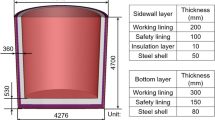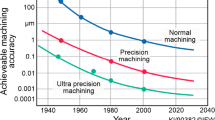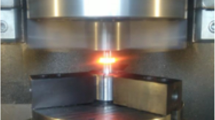Abstract
In order to avoid the sudden failure of high-speed spindles in the actual machining process caused by an excessive temperature rise at the design stage, a three-dimensional (3D) finite element analysis (FEA) model was proposed to conduct transient thermal-structure interactive analysis of a high-speed spindle. The FEA model considered thermal contact resistance (TCR) at solid joints and bearing stiffness to improve the accuracy of traditional thermal models which ignored TCR. However, TCRs at solid joints and bearing stiffness were often ignored in traditional thermal models of high-speed spindles. This caused inaccuracies in traditional thermal models. The heat generation of the built-in motor was calculated based on the efficiency analysis method proposed by Bossmanns and Tu [1]. Based on the quasi-static mechanics analysis of rolling bearing, the heat generation and stiffness of bearings were calculated by applying the Newton-Raphson algorithm to improve the convergence. The Weierstrass-Mandelbrot (W-M) function, a function of fractal parameters, was used to characterize the rough surface morphology of bearing rings. The fractal parameters were identified by the structure function method and the measurement data of bearing ring’s surface morphology, and a contact mechanics model was developed to calculate the contact parameters used in the model of TCR. Then, a new predictive model for TCR was proposed based on M-T model. The above boundary conditions were applied to the FEA model, and thermal equilibrium experiments were conducted to validate the effectiveness of the model. The results showed that the FEA model was much more accurate than the traditional model which ignored TCRs at solid joints and bearing stiffness.
Similar content being viewed by others
References
Bossmanns B, Tu JF (1999) A thermal model for high speed motorized spindles. Int J Mach Tools Manuf 39(9):1345–1366
Donmez MA, Hahn MH, Soons JA (2007) A novel cooling system to reduce thermally-induced errors of machine tools. Ann CIRP 56(1):521–524
Bryan JB (1990) International status of thermal error research. Ann CIRP 39(2):645–656
Su H, Lu L, Liang Y, Zhang Q, Sun Y (2014) Thermal analysis of the hydrostatic spindle system by the finite volume element method. Int J Adv Manuf Technol 71(9–12):1949–1959
Liang Y, Su H, Lu L, Chen W, Sun Y, Zhang P (2014) Thermal optimization of an ultra-precision machine tool by the thermal displacement decomposition and counteraction method. Int J Adv Manuf Technol 1–11
Zivkovic A, Zeljkovic M, Tabakovic S, Milojevic Z (2014) Mathematical modeling and experimental testing of high-speed spindle behavior. Int J Adv Manuf Technol 1–16
Kim SM, Lee SK (2005) Spindle housing design parameter optimization considering thermo-elastic behavior. Int J Adv Manuf Technol 25(11–12):1061–1070
Babu SR, Raja VP, Thyla PR, Thirumalaimuthukumaran M (2014) Prediction of transient thermo-mechanical behavior of the headstock assembly of a CNC lathe. Int J Adv Manuf Technol 74(1–4):17–24
Zhang J, Feng P, Chen C, Yu D, Wu Z (2013) A method for thermal performance modeling and simulation of machine tools. Int J Adv Manuf Technol 68(5–8):1517–1527
Liu Z, Pan M, Zhang A, Zhao Y, Yang Y, Ma C (2014) Thermal characteristic analysis of high-speed motorized spindle system based on thermal contact resistance and thermal-conduction resistance. Int J Adv Manuf Technol 1–14
Su H, Lu L, Liang Y, Zhang Q, Sun Y, Liu H (2014) Finite element fractal method for thermal comprehensive analysis of machine tools. Int J Adv Manuf Technol 75(9–12):1517–1526
Kylander G (1995) Thermal modelling of small cage induction motors. Dissertation, Chalmers University of Technology
Harris TA (1991) Rolling bearing analysis. Wiley, New York
Jones AB (1960) A general theory for elastically constrained ball and radial roller bearings under arbitrary load and speed conditions. J Fluids Eng 82(2):309–320
Incropera FP (2011) Fundamentals of heat and mass transfer. Wiley, New York
Min X, Shuyun J, Ying C (2007) An improved thermal model for machine tool bearings. Int J Mach Tools Manuf 47(1):53–62
Gnielinski V, Kabalec S, Kind M, Martin H, Mewes D, Faber K, Stephan P (2006) VDI-Wärmeatlas. Springer, Berlin
Schmidt F (1967) Waermeuebergang und Druckverlust in Rohr-schlagen. Chemische Ingenieur Technik 39
Mikić BB (1974) Thermal contact conductance: theoretical considerations. Int J Heat Mass Transfer 17(2):205–214
Yovanovich MM (1982) Thermal contact correlations. AIAA Paper 81–1164:83–95
Greenwood JA, Williamson JBP (1966) Contact of nominally flat surfaces. Proc R Soc Lond A 295(1442):300–319
Cooper MG, Mikic BB, Yovanovich MM (1969) Thermal contact conductance. Int J Heat Mass Transfer 12(3):279–300
McWaid TH, Marschall E (1993) A comparison of elastic and plastic contact models for the prediction of thermal contact conductance. Wärme Stoffübertragung 28(8):441–448
Berry MV, Lewis ZV (1980) On the Weierstrass-Mandelbrot fractal function. Proc R Soc Lond A 370(1743):459–484
Majumdar A, Tien CL (1991) Fractal network model for contact conductance. J Heat Transfer 113(3):516–525
Bhushan B, Majumdar A (1992) Elastic-plastic contact model for bifractal surfaces. Wear 153(1):53–64
Majumdar A, Bhushan B (1991) Fractal model of elastic-plastic contact between rough surfaces. J Tribol 113(1):1–11
ISO 230–3 (2007) Test code for machine tools—part 3: determination of thermal effects. Switzerland: ISO copyright office
Author information
Authors and Affiliations
Corresponding author
Rights and permissions
About this article
Cite this article
Ma, C., Mei, X., Yang, J. et al. Thermal characteristics analysis and experimental study on the high-speed spindle system. Int J Adv Manuf Technol 79, 469–489 (2015). https://doi.org/10.1007/s00170-015-6821-z
Received:
Accepted:
Published:
Issue Date:
DOI: https://doi.org/10.1007/s00170-015-6821-z




